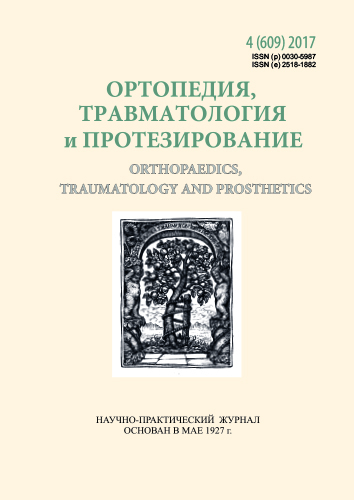Healing of severe polystructural limb wounds using vacuum therapy
DOI:
https://doi.org/10.15674/0030-59872017457-61Keywords:
treatment with negative pressure, polystructural injuries, wound healing, combat traumaAbstract
Vacuum-assisted wound closure has been known for the last two decades as an economically viable and effective treatment method, but the variety of patient injuries caused by severe polystructural (including combat) injuries requires further research into the effect of negative pressure on wound healing.
Objective: to study the possibilities of vacuum-assisted wound closure therapy for the early management of patients with severe open polystructural injuries of limbs with fragmentation or gunshot character in comparison with conventional therapy.
Methods: the results of treatment of 34 patients (men, mean age (30 ± 6) years) with open severe musculoskeletal injuries of the lower and upper extremities, which are accompanied by problems of primary closure of the wound, are analyzed. Before the application of vacuum-assisted wound closure therapy or traditional treatment, all patients had wound sanation and fasciotomy. Eighteen patients were included in the study group who underwent variable negative pressure. Standard wound treatment with antiseptics and the imposition of gauze dressings were applied in 16 affected control group. The condition of the wound was checked on the third and seventh day of treatment. The rate of healing was determined, which was determined by the difference between the initial areas and the areas identified during the study stage.
Results: a significant decrease in the average wound area with Vacuum-assisted wound closure therapy (1.6 cm2 after 3 days, 3.9 cm2 after 7 hours) was recorded in comparison with the traditional method (0.8 and 3 cm2, respectively).
Conclusions: a significant increase in the rate of initial healing of complex fragmentation and gunshot wounds in patients with vacuum-assisted wound closure therapy compared with traditional treatment in a control group was demonstrated. Primary application of vacuum-assisted wound closure therapy is most effective in the period corresponding to the second phase of the wound healing (3–7 days).
References
- Thies CO, Díaz-Gutiérrez AJ, Caba-Doussoux P. Indication for vacuum-assisted wound closure: when, where and why? European Instructional Lectures. 2014;14:47–59. doi: 10.1007/978-3-642-54030-1_5.
- Rushai AK, Bodachenko AK. The role of VAC-drainage in the treatment of extensive necrotic soft tissue defects in patients with open fractures of long tubular bones of extremities. Trauma. 2013;14(5):64-5. (in Russian)
- Obolensky VN, Semenet AYu , Nikitin VG, Sychev DV. Vacuum therapy in the treatment of wounds and wound infection. RMJ. 2010;(17):1064–9. Available from: https://www.rmj.ru/articles/khirurgiya/Vakuumterapiya_v_lechenii_ran_i_ranevoy_infekcii///Unfallchirurg. (in Russian)
- Mouës CM, van den Bemd GJ, Heule F, Hovius SE. Comparing conventional gauze therapy to vacuum-assisted closure wound therapy: a prospective randomised trial. J Plast Reconstr Aesthetic Surg. 2007;60(6):672–81. doi: 10.1016/j.bjps.2006.01.041.
- Fleischmann W, Strecker W, Bombelli M, Kinzl L. Vacuum sealing as treatment of soft tissue damage in open fractures. 1993;96(6):488–92.
- Plikaitis CM, Molnar JA. Subatmospheric pressure wound therapy and the vacuum-assisted closure device: basic science and current clinical successes. Expert Review of Medical Devices. 2006;3(2):175–84. doi: 10.1586/17434440.3.2.175.
- Morykwas MJ, Argenta LC, Shelton-Brown EI, McGuirt W. Vacuum-assisted closure: a new method for wound control and treatment: animal studies and basic foundation. Ann Plast Surg. 1997;6:553–62.
- Borgquist O, Ingemansson R, Malmsjö M. The influence of low and high pressure levels during negative-pressure wound therapy on wound contraction and fluid evacuation. Plast Reconstr Surg. 2011;127(2):551–99. doi: 10.1097/PRS.0b013e3181fed52a.
- Mendonca DA, Papini R, Price PE. Negative-pressure wound therapy: a snapshot of evidence. Int Wound J. 2006;3(4):261–71. doi: 10.1111/j.1742-481X.2006.00266.x.
- Urschel JD, Scott PG, Williams HT. The effect of mechanical stress on soft and hard tissue repair: a review. Br J Plast Surg. 1988;42(2):182–6.
- McCallon SK, Knight CA, Valiulus JP, Cunningham MW, McCulloch JM, Farinas LP. Vacuum-assisted closure versus saline-moistened gauze in the healing of postoperative diabetic foot wounds. Ostomy Wound Manage. 2000;46(8):28–34.
- Joseph E, Hamori CA, Bergman S, Roaf E, Anastasi GW. A prospective randomized trial of vacuum assisted closure versus standard therapy of chronic non-healing wounds. Wounds. 2000;12(3):60–7.
Downloads
How to Cite
Issue
Section
License
Copyright (c) 2018 Leonid Naumenko, Olexii Horehliad, Andriy Mametyev, Konstantyn Kostrytsya, Andriy Domansky

This work is licensed under a Creative Commons Attribution 4.0 International License.
The authors retain the right of authorship of their manuscript and pass the journal the right of the first publication of this article, which automatically become available from the date of publication under the terms of Creative Commons Attribution License, which allows others to freely distribute the published manuscript with mandatory linking to authors of the original research and the first publication of this one in this journal.
Authors have the right to enter into a separate supplemental agreement on the additional non-exclusive distribution of manuscript in the form in which it was published by the journal (i.e. to put work in electronic storage of an institution or publish as a part of the book) while maintaining the reference to the first publication of the manuscript in this journal.
The editorial policy of the journal allows authors and encourages manuscript accommodation online (i.e. in storage of an institution or on the personal websites) as before submission of the manuscript to the editorial office, and during its editorial processing because it contributes to productive scientific discussion and positively affects the efficiency and dynamics of the published manuscript citation (see The Effect of Open Access).














